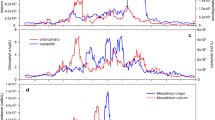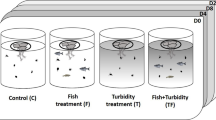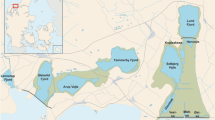Abstract
To investigate the growth and grazing patterns of microzooplankton (MZP) in environments of differing productivity, dilution experiments measuring phytoplankton growth (μ) and grazing mortality (m) rates were performed using samples from contrasting locations along the Texas coast. Samples were collected from estuaries, coastal lagoons and offshore Gulf of Mexico locations in the spring and summer of 2001. MZP growth rates were determined in each dilution treatment. Although MZP biomass changed over time in most dilution treatments, adjusting μ and m for the actual grazer gradient (represented by geometric mean MZP biomass) did not cause a significant deviation from the nominal dilution gradient. Likewise, these adjustments did not yield significant regressions where none existed before adjustment. The dynamics of MZP taxonomic groups (ciliates, dinoflagellates) and size categories differed suggesting that in some cases internal predation may lead to trophic cascades. MZP biomass was higher in productive coastal waters and included a larger proportion of dinoflagellates than in the oligotrophic, ciliate-dominated waters of the Gulf of Mexico. The MZP biomass-to-chlorophyll a ratio was lowest in the hypereutrophic Nueces River, where MZP biomass significantly increased in all dilution treatments (net growth rates up to 2 day−1) suggesting a strong top–down control. In the brown-tide dominated Upper Laguna Madre and the oligotrophic seagrass-dominated Lower Laguna Madre MZP growth was decoupled from that of phytoplankton. At these sites, MZP were likely fueled by bacterial carbon and mixotrophy, respectively. Observing the growth response of MZP in dilution experiments can provide insight into trophic structure and efficiency of the microbial food web.









Similar content being viewed by others
References
Archer SD, Leakey RJG, Burkill PH, Sleigh MA (1996) Microbial dynamics in coastal waters of East Antarctica: herbivory by heterotrophic dinoflagellates. Mar Ecol Prog Ser 139:239–255
Arenovski AL, Lim EL, Caron DA (1995) Mixotrophic nanoplankton in oligotrophic surface waters of the Sargasso Sea may employ phagotrophy to obtain major nutrients. J Plankton Res 17:801–820
Azam F, Fenchel T, Field JG, Gray JS, Meyer-Reil LA, Thingstad F (1983) The ecological role of water-column microbes in the sea. Mar Ecol Prog Ser 10:257–263
Banse K (1982) Cell volumes, maximal growth-rates of unicellular algae and ciliates, and the role of ciliates in the marine pelagial. Limnol Oceanogr 27:1059–1071
Boissonneault-Cellineri KR, Mehta M, Lonsdale DJ, Caron DA (2001) Microbial food web interactions in two Long Island embayments. Aquat Microb Ecol 26:139–155
Burkill PH, Mantoura RFC, Llewellyn CA, Owens NJP (1987) Microzooplankton grazing and selectivity of phytoplankton in coastal waters. Mar Biol 93:581–590
Burkill PH, Edwards ES, John AWG, Sleigh MA (1993) Microzooplankton and their herbivorous activity in the Northeastern Atlantic Ocean. Deep-Sea Res Part II-Topical Studies Oceanogr 40:479–493
Buskey EJ, Hyatt CJ (1995) Effects of the Texas (USA) brown-tide alga on planktonic grazers. Mar Ecol Prog Ser 126:285–292
Buskey EJ, Coulter C, Strom S (1993) Locomotory patterns of microzooplankton: potential effects on food selectivity of larval fish. Bull Mar Sci 53:29–43
Calbet A (2001) Mesozooplankton grazing effect on primary production: a global comparative analysis in marine ecosystems. Limnol Oceanogr 46:1824–1830
Calbet A, Landry MR (1999) Mesozooplankton influences on the microbial food web: direct and indirect trophic interactions in the oligotrophic open ocean. Limnol Oceanogr 44:1370–1380
Calbet A, Landry MR (2004) Phytoplankton growth, microzooplankton grazing, and carbon cycling in marine systems. Limnol Oceanogr 49:51–57
Calbet A, Saiz E (2005) The ciliate-copepod link in marine ecosystems. Aquat Microb Ecol 38:157–167
Carey PG (1992) Marine interstitial ciliates: an illustrated key. Chapman and Hall, London
Christaki U, Van Wambeke F (1995) Simulated phytoplankton bloom input in top-down manipulated microcosms: comparative effect of zooflagellates, ciliates and copepods. Aquat Microb Ecol 9:137–147
Dolan JR, Perez MT (2000) Costs, benefits and characteristics of mixotrophy in marine oligotrichs. Freshw Biol 45:227–238
Dolan JR, McKeon K (2005) The reliability of grazing rate estimates from dilution experiments: have we over-estimated rates of organic carbon consumption by microzooplankton? Ocean Sci 1:1–7
Dolan JR, Gallegos CL, Moigis A (2000) Dilution effects on microzooplankton in dilution grazing experiments. Mar Ecol Prog Ser 200:127–139
Fahnenstiel GL, McCormick MJ, Lang GA, Redalje DG, Lohrenz SE, Markowitz M, Wagoner B, Carrick HJ (1995) Taxon-specific growth and loss rates for dominant phytoplankton populations from the Northern Gulf of Mexico. Mar Ecol Prog Ser 117:229–239
Fenchel T (1987) Ecology of protozoa : the biology of free-living phagotrophic protists. Science Tech Publishers, Madison
Fileman E, Burkill P (2001) The herbivorous impact of microzooplankton during two short-term Lagrangian experiments off the NW coast of Galicia in summer 1998. Prog Oceanogr 51:361–383
Fonda Umani S, Beran A (2003) Seasonal variations in the dynamics of microbial plankton communities: first estimates from experiments in the Gulf of Trieste, Northern Adriatic Sea. Mar Ecol Prog Ser 247:1–16
Froneman PW (2002) Trophic cascading in an oligotrophic temperate estuary, South Africa. J Plankton Res 24:807–816
Gallegos CL (1989) Microzooplankton grazing on phytoplankton in the Rhode River, Maryland—nonlinear feeding kinetics. Mar Ecol Prog Ser 57:23–33
Gallegos CL, Vant WN, Safi KA (1996) Microzooplankton grazing of phytoplankton in Manukau Harbour, New Zealand. N Z J Mar Freshw Res 30:423–434
Gaul W, Antia AN (2001) Taxon-specific growth and selective microzooplankton grazing of phytoplankton in the Northeast Atlantic. J Mar Syst 30:241–261
Irigoien X, Flynn KJ, Harris RP (2005) Phytoplankton blooms: a ‘loophole’ in microzooplankton grazing impact? J Plankton Res 27:313–321
Jochem FJ, McCarthy MJ, Gardner WS (2004) Microbial ammonium cycling in the Mississippi River plume during the drought spring of 2000. J Plankton Res 26:1265–1275
Juhl AR, Murrell MC (2005) Interactions between nutrients, phytoplankton growth, and microzooplankton grazing in a Gulf of Mexico estuary. Aquat Microb Ecol 38:147–156
Kaldy JE, Onuf CP, Eldridge PM, Cifuentes LA (2002) Carbon budget for a subtropical seagrass dominated coastal lagoon: how important are seagrasses to total ecosystem net primary production? Estuaries 25:528–539
Landry MR (1993) Estimating rates of growth and grazing mortality of phytoplankton by the dilution method. In: Kemp PF (ed) Handbook of methods in aquatic microbial ecology. Lewis Publishers, Boca Raton, pp 777
Landry MR, Hassett RP (1982) Estimating the grazing impact of marine micro-zooplankton. Mar Biol 67:283–288
Landry MR, Calbet A (2005) Reality checks on microbial food web interactions in dilution experiments: responses to the comments of Dolan and McKeon. Ocean Sci 1:39–44
Landry MR, Kirshtein J, Constantinou J (1995) A refined dilution technique for measuring the community grazing impact of microzooplankton, with experimental tests in the central equatorial Pacific. Mar Ecol Prog Ser 120:53–63
Lavrentyev PJ, Gardner WS, Cavaletto JF, Beaver JR (1995) Effects of the zebra mussel (Dreissena polymorpha Pallas) on protozoa and phytoplankton from Saginaw Bay, Lake Huron. J Great Lakes Res 21:545–557
Lavrentyev PJ, Gardner WS, Johnson JR (1997) Cascading trophic effects on aquatic nitrification: experimental evidence and potential implications. Aquat Microb Ecol 13:161–175
Lavrentyev PJ, McCarthy MJ, Klarer DM, Jochem F, Gardner WS (2004) Estuarine microbial food web patterns in a Lake Erie coastal wetland. Microb Ecol 48:567–577
Legendre L, Rassoulzadegan F (1995) Plankton and nutrient dynamics in marine waters. Ophelia 41:153–172
Lewitus AJ, Koepfler ET, Morris JT (1998) Seasonal variation in the regulation of phytoplankton by nitrogen and grazing in a salt-marsh estuary. Limnol Oceanogr 43:636–646
Liu HB, Buskey EJ (2000) The exopolymer secretions (EPS) layer surrounding Aureoumbra lagunensis cells affects growth, grazing, and behavior of protozoa. Limnol Oceanog 45:1187–1191
Liu HB, Dagg MJ, Wu CJ, Chiang KP (2005) Mesozooplankton consumption of microplankton in the Mississippi River plume, with special emphasis on planktonic ciliates. Mar Ecol Prog Ser 286:133–144
Lynn DH, Gilron GL (1993) Strombidiid ciliates from coastal waters near Kingston Harbor, Jamaica (Ciliophora, Oligotrichia, Strombidiidae). J Mar Biol Assoc UK 73:47–65
Menden-Deuer S, Lessard EJ (2000) Carbon to volume relationships for dinoflagellates, diatoms, and other protist plankton. Limnol Oceanogr 45:569–579
Menden-Deuer S, Lessard EJ, Satterberg J (2001) Effect of preservation on dinoflagellate and diatom cell volume and consequences for carbon biomass predictions. Mar Ecol Prog Ser 222:41–50
Montagnes DJS, Lessard EJ (1999) Population dynamics of the marine planktonic ciliate Strombidinopsis multiauris: its potential to control phytoplankton blooms. Aquat Microb Ecol 20:167–181
Müller H, Geller W (1993) Maximum growth-rates of aquatic ciliated protozoa: the dependence on body size and temperature reconsidered. Arch Hydrobiol 126:315–327
Murrell MC, Hollibaugh JT (1998) Microzooplankton grazing in northern San Francisco Bay measured by the dilution method. Aquat Microb Ecol 15:53–63
Murrell M, Stanley R, Lores E, DiDonato G, Flemer D (2002) Linkage between microzooplankton grazing and phytoplankton growth in a Gulf of Mexico estuary. Estuaries 25:19–29
Nagasaki K, Tomaru Y, Takao Y, Nishida K, Shirai Y, Suzuki H, Nagumo T (2005) Previously unknown virus infects marine diatom. Appl Environ Microbiol 71:3528–3535
Petz W (1995) Morphology and morphogenesis of Thigmokeronopsis antarctica Nov-Spec and T. Crystallis Nov-Spec (Ciliophora, Hypotrichida) from Antarctic sea-ice. Eur J Protistol 31:137–147
Pomeroy LR (2001) Caught in the food web: complexity made simple? Sci Mar 65:31–40
Putt M, Stoecker DK (1989) An experimentally determined carbon-volume ratio for marine oligotrichous ciliates from estuarine and coastal waters. Limnol Oceanogr 34:1097–1103
Reckermann M, Veldhuis MJW (1997) Trophic interactions between picophytoplankton and micro- and nanozooplankton in the western Arabian Sea during the NE monsoon 1993. Aquat Microb Ecol 12:263–273
Samuelsson K, Andersson A (2003) Predation limitation in the pelagic microbial food web in an oligotrophic aquatic system. Aquat Microb Ecol 30:239–250
Samuelsson K, Berglund J, Haecky P, Andersson A (2002) Structural changes in an aquatic microbial food web caused by inorganic nutrient addition. Aquat Microb Ecol 29:29–38
Sellner KG, Brownlee DC, Bundy MH, Brownlee SG, Braun KR (1993) Zooplankton grazing in a Potomac River cyanobacteria bloom. Estuaries 16:859–872
Sherr EB, Sherr BF (2002) Significance of predation by protists in aquatic microbial food webs. Antonie Van Leeuwenhoek International J Gen Mol Microb 81:293–308
Small EB, Lynn DH (1985) Phylum Ciliophora Doflein, 190l. In: Lee JJ, Hunter SH, Bovee EC (eds) An illustrated guide to the protozoa. Society of Protozoologists, Lawrence, pp 393–575
Steidinger KA, Tangen K (1993) Dinoflagellates. In: Tomas CR, Throndsen J, Heimdal BR (eds) Marine phytoplankton: a guide to naked flagellates and coccolithophorids. Academic, San Diego, pp 263
Stoecker DK, Gifford DJ, Putt M (1994) Preservation of marine planktonic ciliates: losses and cell shrinkage during fixation. Mar Ecol Prog Ser 110:293–299
Stoecker DK, Stevens K, Gustafson DE (2000) Grazing on Pfiesteria piscicida by microzooplankton. Aquat Microb Ecol 22:261–270
Strom SL, Brainard MA, Holmes JL, Olson MB (2001) Phytoplankton blooms are strongly impacted by microzooplankton grazing in coastal North Pacific waters. Mar Biol 138:355–368
Suzuki Y, Takahashi M (1995) Growth responses of several diatom species isolated from various environments to temperature. J Phycol 31:880–888
Turner JT, Roff JC (1993) Trophic levels and trophospecies in the marine plankton: lessons from the microbial food web. Mar Microb Food Webs 7:225–248
Welschmeyer NA (1994) Fluorometric analysis of chlorophyll-a in the presence of chlorophyll-b and pheopigments. Limnol Oceanogr 39:1985–1992
Wetzel RG, Likens GE (1991) Limnological analysis. Springer, New York
Wilks SA, Sleigh MA (1998) Grazing rates in Euplotes mutabilis: relationship between particle size and concentration. Microb Ecol 36:165–174
Acknowledgments
The University of Akron Graduate Program and the Nancy Lee and Perry Bass Endowed Chair funding to the University of Texas at Austin Marine Science Institute (UTMSI) supported this work. W.S. Gardner and M.J. McCarthy generously assisted with logistics, sampling and analyses. We are extremely grateful for their support. MRF also received support from the University of Georgia Graduate Fellowship. We thank K.H. Dunton and his students who shared space on the Laguna Madre cruise and the personnel at UTMSI and captain and crew of R/V Longhorn who assisted with this work. R.J. Duff and L. Fraser assisted much with the preparation of the thesis on which this work is based. A.M. Modugno was generous in her support and editorial skills. The comments and suggestions of three anonymous reviewers greatly improved this manuscript.
Author information
Authors and Affiliations
Corresponding author
Additional information
Communicated by J.P. Grassle.
Rights and permissions
About this article
Cite this article
First, M.R., Lavrentyev, P.J. & Jochem, F.J. Patterns of microzooplankton growth in dilution experiments across a trophic gradient: Implications for herbivory studies. Mar Biol 151, 1929–1940 (2007). https://doi.org/10.1007/s00227-007-0629-9
Received:
Accepted:
Published:
Issue Date:
DOI: https://doi.org/10.1007/s00227-007-0629-9




